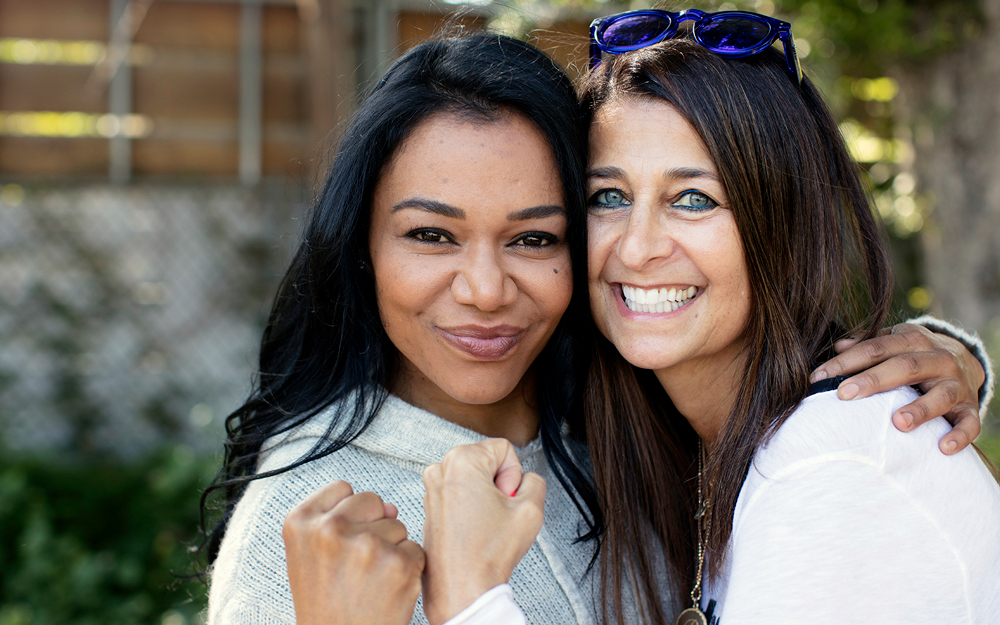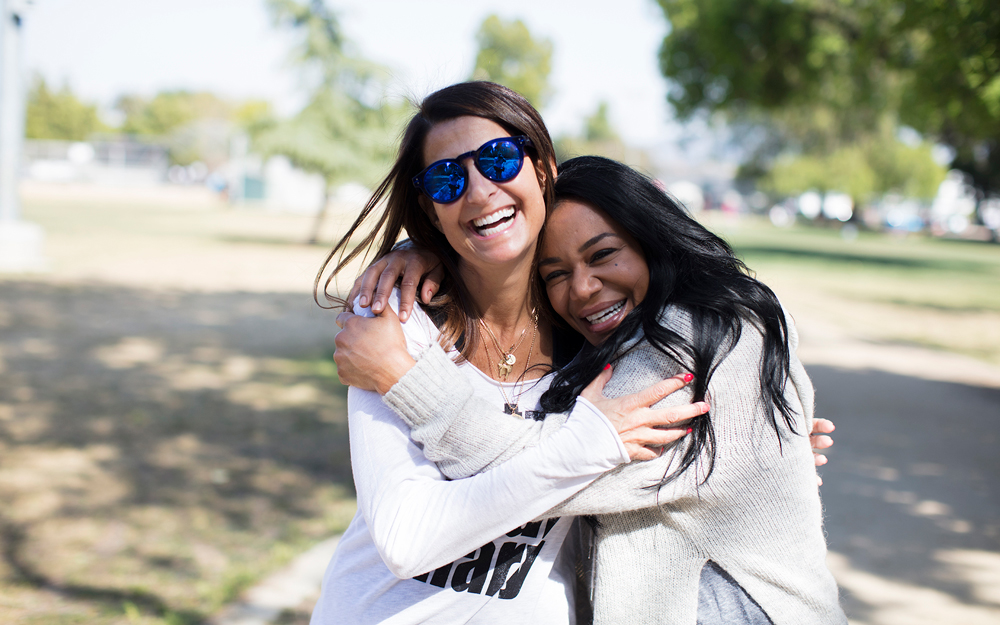Catalyst
Real-Life Superheroes
May 16, 2017 Cedars-Sinai Staff

Barb Sachs walked the nine blocks from her apartment to the grocery store to pick up lunch.
For the details of what happened next, she rattles off a litany she's gathered from police reports, eyewitnesses and her doctor: On July 15 around 11:15 am, as Barb crossed the street, a car turned left and hit her, flipping Barb onto the hood of the driver's car. Barb's head smashed against the windshield, then she dropped to the ground covered in shards of glass.
"It's a brilliant thing what trauma does, because I have no memory of what happened," says Barb, 56. "I don't even remember what I wore."
While others panicked, a quick-thinking bystander sprang into action, applying ice packs, calling 911 and picking glass out of Barb's hair. Paramedics arrived and recognized Barb needed a level one trauma center, so they took her to Cedars-Sinai.
"It's a brilliant thing what trauma does. I don't even remember what I wore."
Barb had a traumatic brain injury (TBI). She had two emergency brain surgeries and spent a total of 20 days in the hospital, including 2 weeks in a coma. It's a story of real-life heroes, Barb says of her surgeon, care team, and every person who had a role in her rescue.
Barb belongs on that list too, though she wouldn't say so.
A hero on the scene
Keta Meggett isn't just a real-life hero. She also plays one on television: She's Keta Rush, Women of Wrestling's Bully Buster, billed as using brains and brawn to battle bullies in the ring and outside it.
It's not wholly fiction: After being beaten up by 8 girls when she was a high school freshman, she spent a week in the hospital, then months in physical therapy. Keta founded a nonprofit to teach kids the things she wish she'd known when she was jumped by bullies: confidence, leadership, and self defense.
On that hot day in July 2016, Keta, 38, sat behind the wheel of her white SUV, right-turn signal clacking as she waited at the busy intersection of Laurel Canyon and Riverside. She was in physical therapy, this time because she'd been T-boned in her car 6 months earlier. She wore 6 ice packs strapped to her body.
"If you can hear me, stay with me, please."
Keta remembers everything about that day in impressive detail.
"It was like a terrifying version of the Mannequin Challenge," she says. "Everyone was just staring and screaming, but nobody did anything. No one was next to Barb. It was the weirdest thing."
Everyone seemed to be still for a few seconds at first. Then some started screaming while others embraced each other. No one helped the woman lying in the crosswalk.
Keta dashed toward the injured woman. Her body and brain kicked into high gear: She noted Barb was in shorts and that the pavement was scorching in the 105-degree heat. She grabbed a hoodie from her car and got to work.
She shaded Barb while pulling the ice packs from her own body to place on Barb's head, legs, and chest to keep swelling down. She called 911, picking glass shards out of Barb's curly hair while checking her pulse and saying to her, "If you can hear me, stay with me, please."
Paramedics pulled up in an ambulance and took over. Keta gathered up the scrunchie, credit cards, wallet, keys, and ear buds on the ground and handed them to a paramedic. She noticed the woman's striking aqua-colored eyes when a paramedic lifted her eyelid to check her pupils.
The ambulance roared away as Keta prayed for the woman inside.
"My spirit was traumatized," she says.
Read: Surviving a Brain Attack
Making the connection
Keta wanted to know the woman she helped was ok. She found the responders, but patient privacy laws prevented them from telling her much. They did mention that they didn't think the woman was from Los Angeles.
Keta had a name she'd spied on a credit card and those bright aqua eyes to go on. After searching through hundreds of images online, Keta found a photo and recognized Barb. From there, she found a Facebook account and connected with Barb's son Jake. They began swapping messages. He gave her updates and she offered encouragement and support.
In Discoveries: Headway in Traumatic Brain Injuries
Recovery
Barb had lived in Los Angeles only three months before she was injured. She'd moved from Minnesota to be near Jake. She has a rare blood disease called polycythemia vera, a slow-growing cancer that causes the bone marrow to make too many red blood cells. The condition can thicken the blood and cause clots.
She'd visited a couple of hematologists, including one at Cedars-Sinai, looking for someone in LA to help manage her treatment.
She had no idea that visiting a Cedars-Sinai doctor would help save her life: Staff in the emergency room pulled up her electronic medical record and were alerted that she had the disease.
Everyone told Barb to brace for a long recovery: up to 18 months living in a facility with round-the-clock care.
Barb had other plans.
This prompted Dr. Michael Alexander, director of the Neurovascular Center and Endovascular Neurology, to give Barb an infusion of platelets at the time of her emergency surgery. She required 2 surgeries: one to fix a blood clot, and a second six hours later when another bleed turned up.
Weeks later, Barb had the first meeting with Dr. Alexander that she remembered.
"He said, 'Honestly, you saved your life too: In the three months you lived here, you saw our hematologists, and so you were in our computer,'" Barb says. "I was coming from a serious trauma, and I have a bleeding disease—and he knew what to do because I was in the system."
After 20 days in the hospital, Barb was released to a rehabilitation program. Everyone told her to brace for a long recovery: up to 18 months living in a facility with round-the-clock care.
Barb had other plans.
Read: The Luckiest Unlucky Kid
Despite her brain injury, her mind and wit were as sharp as ever. She could get up and move around with relative ease.
She was back in her apartment a month after the accident, receiving follow-up treatment and physical therapy on an outpatient basis.
Jake stayed by her side in the hospital and the rehab facility. In her first days back home, he ran errands for her, made sure she was settling in and that she wasn't in danger of falling.
"I cried tears of such happiness, lying in my own bed with my own sheets," Barb says. "I was able to do everything myself."
She regularly called Dr. Alexander's office, chatting with his staff to give updates and get questions answered.
Cognitive therapy, occupational therapy, and physical therapy continued for months.
"You gotta get stronger. You gotta get stronger. That's what I keep saying to myself, and I think I have."
As part of her recovery, she exercises and takes walks on her own—never with her cellphone in hand or anything that could distract her. She started with 15-minute walks a couple of times a day, then worked up to 2 miles with ease.
She also needed to rebuild her muscles and improve her balance and coordination. She took up Pilates.
"It's really tough," says Barb. "You gotta get stronger. You gotta get stronger. That's what I keep saying to myself, and I think I have."
At the same time, she works her mind. On Dr. Alexander's advice, she's reading more to exercise her brain.
"I encourage people recovering from brain injuries to do things that challenge or work their brain, such as reading or puzzles," he says. "For a muscle to recover after injury, it requires progressive therapy to improve strength and endurance. I believe the brain is the same. If you don't use it, you lose it."
Barb has picked up mostly nonfiction, especially books about bettering the brain.
She also returned to working cryptograms, tricky coded word puzzles she unravels with her beloved aunt Bette Goldfarb, who is 95 and phones Barb daily.

Barb Sachs and Keta Meggett
Reunited
Keta and Barb reunited in October, just over 3 months after Keta came to Barb's rescue. They hugged and caught up, Barb talking about her treatment, Keta giving Barb details of the collision that she hadn't known.
"I couldn't stop hugging her, and I couldn't stop crying," Keta says.
The two live close to each other in Valley Village. Since the reunion, they've become fast friends. They lunch together and text, and sometimes Barb's son Jake tags along.
"She will be in my life for the rest of my life," Barb says.
Keta and Jake have a rapport like siblings, bantering and teasing Barb as though she were a mom to both of them.
"From the moment she came to meet me, she called me mama," Barb says. "Even whens she texts me. 'I love you, mama,' she writes."
"I couldn't stop hugging her, and I couldn't stop crying."
Barb is especially touched that Keta stayed with her until the paramedics drove her away. She didn't just call 911; she did everything she could think of to help save her life.
Keta says she was just doing what instinctively felt like the right thing.
"I cannot believe what one human being has been through, and what she's accomplished and who she is today."
Barb said that about Keta, but the sentiment seems to run both ways.
"I had angels at the scene," Barb says.
It was lucky, Dr. Alexander said, that Keta had ice and thought to put it on her head.
"There's some preliminary information that low temperature can protect the brain. It's difficult to say whether this had an impact on Barb, but it was very insightful on the part of Keta," he says.
"From the people who work at the desks on every floor in the towers, to the doctors and nurses, the valet people on the ramps and the staff on the patient floors—the kindness of everyone is amazing."
Barb is grateful that she ended up at Cedars-Sinai, even though other hospitals were closer to the collision scene. She went back to the intensive care unit and the 8th floor to visit the nurses and others who took care of her.
She hopes to see them again, and to become a volunteer herself.
"From the people who work at the desks on every floor in the towers, to the doctors and nurses, the valet people on the ramps and the staff on the patient floors—the kindness of everyone is amazing," she says. "I've never experienced anything else like it in my life."
"I think about all the donors who have put everything together. I looked at the names on all the buildings, and looked into the backstories, and they're just wonderful. I am so grateful for what they've done.
"I will spend the rest of my life volunteering, talking, and doing whatever I can for Cedars-Sinai."
Barb is a grateful patient and supporter of the Campaign for Cedars-Sinai. Learn more about the Campaign.
Are you a grateful patient, family member, volunteer, or loyal supporter? We want to hear from you. Your story can inspire others who may be facing similar challenges—and most importantly, provide hope. Share your story of gratitude or see how others are sharing #CedarsGratitude.



